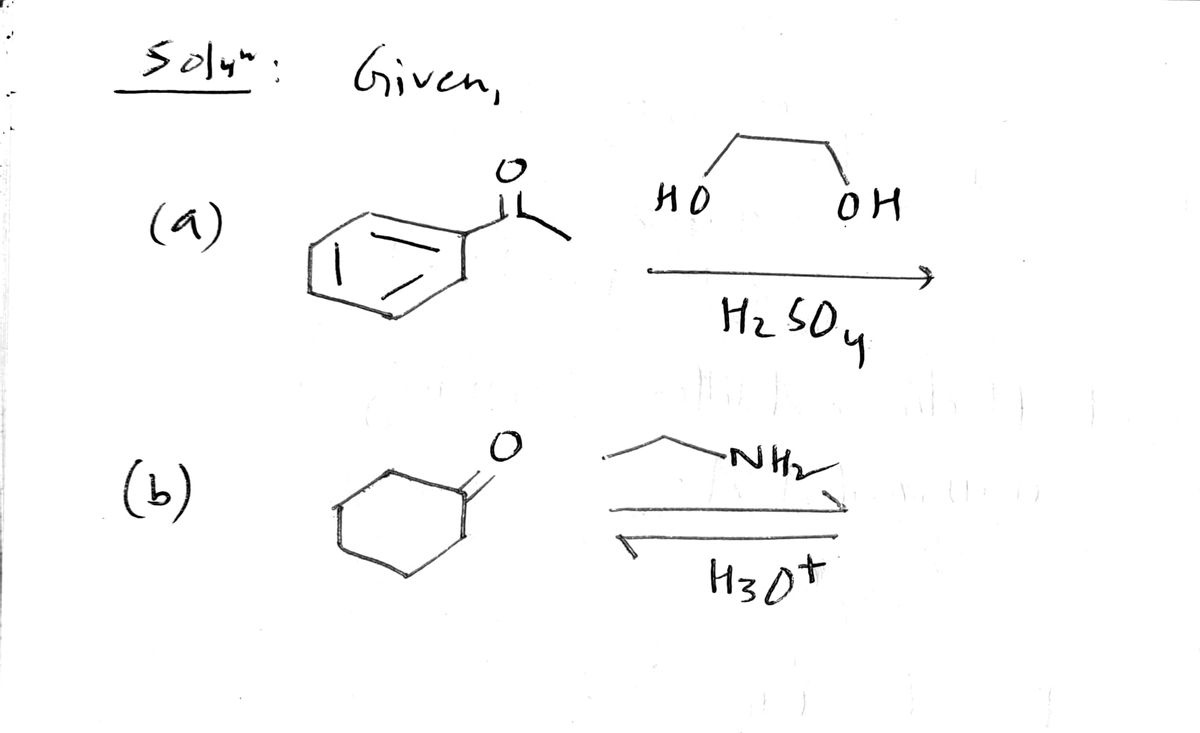Chemistry
10th Edition
ISBN:9781305957404
Author:Steven S. Zumdahl, Susan A. Zumdahl, Donald J. DeCoste
Publisher:Steven S. Zumdahl, Susan A. Zumdahl, Donald J. DeCoste
Chapter1: Chemical Foundations
Section: Chapter Questions
Problem 1RQ: Define and explain the differences between the following terms. a. law and theory b. theory and...
Related questions
Question

Transcribed Image Text:**Exercise 4: Predict the Major Product(s) for the Following Reactions**
**(a) Reaction Details:**
- **Reactant:** A benzene ring with an acetone substituent (phenyl-acetone).
- **Reagent:** Ethylene glycol (HO-CH2-CH2-OH).
- **Catalyst/Condition:** Sulfuric acid (H2SO4).
**Explanation:** This reaction involves the protection of the carbonyl group in phenyl acetone by forming an acetal with ethylene glycol under acidic conditions. The expected major product is an acetal where the carbonyl oxygen is replaced by ethylene glycol forming a cyclic acetal.
---
**(b) Reaction Details:**
- **Reactant:** Cyclohexanone.
- **Reagent:** Ethylamine (CH3CH2NH2).
- **Catalyst/Condition:** Hydronium ion (H3O+).
**Explanation:** This reaction involves the formation of an imine from cyclohexanone and ethylamine under acidic conditions. The oxygen of the carbonyl group is replaced by an imine group, resulting in the formation of a cyclohexylidene amine (Schiff base).
---
These reactions represent common carbonyl chemistry, illustrating acetal and imine formation, which are important in synthetic organic chemistry for protecting carbonyl groups and forming new carbon-nitrogen bonds, respectively.
Expert Solution
Step 1
First reaction is protection of ketone via diol in acidic medium...
Step by step
Solved in 3 steps with 3 images

Knowledge Booster
Learn more about
Need a deep-dive on the concept behind this application? Look no further. Learn more about this topic, chemistry and related others by exploring similar questions and additional content below.Recommended textbooks for you

Chemistry
Chemistry
ISBN:
9781305957404
Author:
Steven S. Zumdahl, Susan A. Zumdahl, Donald J. DeCoste
Publisher:
Cengage Learning

Chemistry
Chemistry
ISBN:
9781259911156
Author:
Raymond Chang Dr., Jason Overby Professor
Publisher:
McGraw-Hill Education

Principles of Instrumental Analysis
Chemistry
ISBN:
9781305577213
Author:
Douglas A. Skoog, F. James Holler, Stanley R. Crouch
Publisher:
Cengage Learning

Chemistry
Chemistry
ISBN:
9781305957404
Author:
Steven S. Zumdahl, Susan A. Zumdahl, Donald J. DeCoste
Publisher:
Cengage Learning

Chemistry
Chemistry
ISBN:
9781259911156
Author:
Raymond Chang Dr., Jason Overby Professor
Publisher:
McGraw-Hill Education

Principles of Instrumental Analysis
Chemistry
ISBN:
9781305577213
Author:
Douglas A. Skoog, F. James Holler, Stanley R. Crouch
Publisher:
Cengage Learning

Organic Chemistry
Chemistry
ISBN:
9780078021558
Author:
Janice Gorzynski Smith Dr.
Publisher:
McGraw-Hill Education

Chemistry: Principles and Reactions
Chemistry
ISBN:
9781305079373
Author:
William L. Masterton, Cecile N. Hurley
Publisher:
Cengage Learning

Elementary Principles of Chemical Processes, Bind…
Chemistry
ISBN:
9781118431221
Author:
Richard M. Felder, Ronald W. Rousseau, Lisa G. Bullard
Publisher:
WILEY